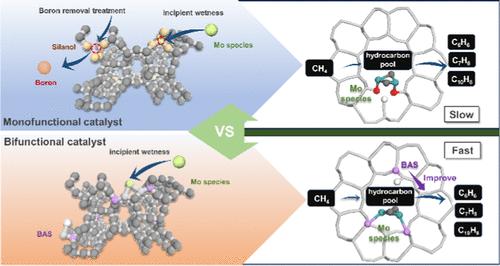当前位置:
X-MOL 学术
›
ACS Catal.
›
论文详情
Our official English website, www.x-mol.net, welcomes your feedback! (Note: you will need to create a separate account there.)
Brønsted Acid Site Catalytic Role in Methane Dehydroaromatization over Mo/HZSM-5
ACS Catalysis ( IF 11.3 ) Pub Date : 2024-07-20 , DOI: 10.1021/acscatal.4c02300 Hongxiang Zhang 1 , Lihong Wei 1 , Yuewen Sun 1 , Ce Wang 1 , Yanlong Li 1 , Rundong Li 1
ACS Catalysis ( IF 11.3 ) Pub Date : 2024-07-20 , DOI: 10.1021/acscatal.4c02300 Hongxiang Zhang 1 , Lihong Wei 1 , Yuewen Sun 1 , Ce Wang 1 , Yanlong Li 1 , Rundong Li 1
Affiliation

|
Methane dehydroaromatization (MDA) has the potential to be a technology with high environmental efficiency for synthesizing benzene, toluene, and xylenes (BTX) from nonpetroleum feedstocks in a carbon-neutral society. However, a debate presently exists concerning the reaction mechanism of MDA catalysis by the promising Mo/HZSM-5, primarily attributed to the unclear catalytic role of strong Brønsted acid sites (BAS), which significantly hampers the development of highly active and anticoking catalysts. This study aims to resolve the controversy surrounding strong BAS in MDA by comparing the silica zeolite with supported molybdenum (Mo/Bsn-S-1) with Mo/HZSM-5. The Mo/Bsn-S-1 featuring internally anchored molybdenum species was prepared to generate a strong metal–support interaction, which resolved the problem, leading to the incomparable catalytic activity of Mo/Silicalite-1 with Mo/HZSM-5, due to the absence of anchoring sites. By physically mixing the Mo/Bsn-S-1 with HZSM-5 and comparing it to bifunctional catalysts, the study reveals that MDA follows a bifunctional mechanism, predominantly through the hydrocarbon pool mechanism, where strong BAS play a facilitating role. This study demonstrates that strong BAS located in spatial proximity to molybdenum species improve the aromatics yield via the autocatalytic reactions of hydrocarbon pool, while those not in spatial proximities catalyze the cyclization and polycondensation of intermediates into polycyclic aromatics and coke. This study provides crucial evidence in clarifying the debate over the role of strong BAS in MDA and lays an important theoretical foundation for the design of catalysts that better utilize BAS to balance catalytic activity and resistance to coking.
中文翻译:

Mo/HZSM-5 上的布朗斯台德酸位催化甲烷脱氢芳构化作用
甲烷脱氢芳构化(MDA)有潜力成为碳中和社会中从非石油原料合成苯、甲苯和二甲苯(BTX)的高环境效率技术。然而,目前关于Mo/HZSM-5的MDA催化反应机理存在争议,这主要是由于强布朗斯台德酸位点(BAS)的催化作用尚不清楚,这极大地阻碍了高活性和抗结焦催化剂的开发。本研究旨在通过比较负载钼的二氧化硅沸石 (Mo/B sn -S-1) 与 Mo/HZSM-5 来解决有关 MDA 中强 BAS 的争议。制备了具有内部锚定钼物质的Mo/B sn -S-1,以产生强的金属-载体相互作用,解决了这个问题,导致Mo/Silicalite-1具有与Mo无可比拟的催化活性。 /HZSM-5,由于缺乏锚定位点。通过将Mo/B sn -S-1与HZSM-5物理混合并将其与双功能催化剂进行比较,研究表明MDA遵循双功能机制,主要通过烃池机制,其中强BAS发挥作用起到促进作用。这项研究表明,位于空间邻近钼物质的强BAS通过烃池的自催化反应提高芳烃产率,而那些空间不邻近的BAS则催化中间体环化和缩聚成多环芳烃和焦炭。这项研究为澄清关于强BAS在MDA中的作用的争论提供了重要的证据,并为设计更好地利用BAS来平衡催化活性和抗结焦性的催化剂奠定了重要的理论基础。
更新日期:2024-07-22
中文翻译:

Mo/HZSM-5 上的布朗斯台德酸位催化甲烷脱氢芳构化作用
甲烷脱氢芳构化(MDA)有潜力成为碳中和社会中从非石油原料合成苯、甲苯和二甲苯(BTX)的高环境效率技术。然而,目前关于Mo/HZSM-5的MDA催化反应机理存在争议,这主要是由于强布朗斯台德酸位点(BAS)的催化作用尚不清楚,这极大地阻碍了高活性和抗结焦催化剂的开发。本研究旨在通过比较负载钼的二氧化硅沸石 (Mo/B sn -S-1) 与 Mo/HZSM-5 来解决有关 MDA 中强 BAS 的争议。制备了具有内部锚定钼物质的Mo/B sn -S-1,以产生强的金属-载体相互作用,解决了这个问题,导致Mo/Silicalite-1具有与Mo无可比拟的催化活性。 /HZSM-5,由于缺乏锚定位点。通过将Mo/B sn -S-1与HZSM-5物理混合并将其与双功能催化剂进行比较,研究表明MDA遵循双功能机制,主要通过烃池机制,其中强BAS发挥作用起到促进作用。这项研究表明,位于空间邻近钼物质的强BAS通过烃池的自催化反应提高芳烃产率,而那些空间不邻近的BAS则催化中间体环化和缩聚成多环芳烃和焦炭。这项研究为澄清关于强BAS在MDA中的作用的争论提供了重要的证据,并为设计更好地利用BAS来平衡催化活性和抗结焦性的催化剂奠定了重要的理论基础。












































 京公网安备 11010802027423号
京公网安备 11010802027423号